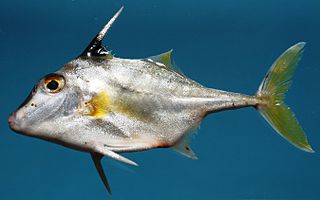
Triacanthidae, the triplespines or tripodfishes, is a family of marine ray-finned fishes belonging to the order Tetraodontiformes, whicj also includes the pufferfishes, boxfishes, filefishes and related groups. The family is made up of four extant genera and three extinct genera which are known from fossils.

The spikefishes are ray-finned fishes related to the pufferfishes and triggerfishes. They live in deep waters; more than 50 m (160 ft), but above the continental shelves. They are found in the Atlantic, Indian Ocean, and the west-central Pacific.

Pseudotriacanthus is a monospecific genus of marine ray-finned fish belonging to the family Triacanthidae, the triplespines or tripodfishes. The only species in this genus is Pseudotriacanthus strigilifer, the longspined tripodfish. This taxon is found in the Indo-West Pacific region.

Triacanthus is a genus of marine ray-finned fish belonging to the family Triacanthidae, the triplespines or tripodfishes. The two species in this genus are found in the Indian Ocean and the western Pacific Ocean.

Tripodichthys is a genus of marine ray-finned fish belonging to the family Triacanthidae, the triplespines or tripodfishes. The three species in this genus are found in the Indian Ocean and the western Pacific Ocean in shallow water over soft substrates.
Atrophacanthus is a monospecific genus of marine ray-finned fish belonging to the family Triacanthodidae, the spikefishes. The only species in the genus is Atrophacanthus japonicus, the upward-mouth spikefish, which is found in the Indo-West Pacific region.
Bathyphylax is a genus of marine ray-finned fishes belonging to the family Triacanthodidae, the spikefishes. The fishes in this genus are found in the deep waters of the Indian and Pacific Oceans.

Halimochirurgus is a genus of marine ray-finned fishes belonging to the family Triacanthodidae, the spikefishes. The fishes in this genus are found in the deep waters of the Indian and Pacific Oceans.

Hollardia is a genus of marine ray-finned fishes belonging to the family Triacanthodidae, the spikefishes. These demersal fishes are found in the Western Atlantic Ocean with one species being found in the Pacific Ocean.
Johnsonina is a monospecific genus of marine ray-finned fish belonging to the family Triacanthodidae, the spikefishes. The only species in the genus is Johnsonina eriomma, the bullseye spikefish, which is found in the Western Atlantic Ocean.

Macrorhamphosodes, the trumpetsnouts, is a genus of marine ray-finned fishes belonging to the family Triacanthodidae, the spikefishes. The fishes in this genus are found in the deep waters of the Indian and Pacific Oceans.
Mephisto fraserbrunneri, the devil's spikefish, is a species of marine ray-finned fish belonging to the family Triacanthodidae, the spikefishes. This species is found in the Indian Ocean.
Mephisto is a genus of marine ray-finned fishes belonging to the family Triacanthodidae, the spikefishes. These fishes are found in the Indian Ocean.

Parahollardia is a genus of marine ray-finned fishes belonging to the family Triacanthodidae, the spikefishes. These demersal fishes are found in the Western Atlantic Ocean.

Paratriacanthodes is a genus of marine ray-finned fishes belonging to the family Triacanthodidae, the spikefishes. These fishes are found found in the Indian and Pacific Oceans.

Triacanthodes is a genus of marine ray-finned fishes belonging to the family Triacanthodidae, the spikefishes. These fishes are found found in the Indian and Pacific Oceans.

Triacanthus biaculeatus, also known as the short-nosed tripod fish, black-finned triple-spine, blacktail tripodfish, hollow-snouted tripodfish or silver tripodfish, is a species of marine ray-finned fish belonging to the family Triacanthidae, the triplespines or tripodfishes. This species is found in the Indo-West Pacific region.

Paratriacanthodes retrospinis, the sawspine spikefish, is a species of marine ray-finned fish belonging to the family Triacanthodidae, the spikefishes. This species is found in the Indo-Pacific region.

Triacanthus nieuhofii, the silver tripodfish, is a species of marine ray-finned fish belonging to the family Triacanthidae, the triplespines or tripodfishes. This species is found in the Indo-West Pacific region.

Triacanthoidei is a suborder of ray-finned fishes belonging to the order Tetraodontiformes, which includes the pufferfishes, triggerfishes and related taxa. These benthic fishes are mainly found in the Indian Ocean with some of the spikefishes found in the Western Atlantic Ocean.










